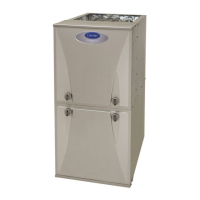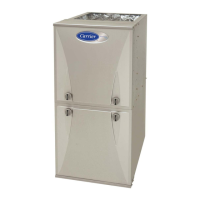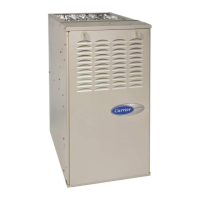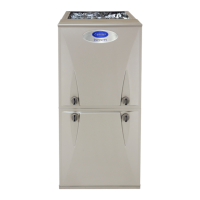PG96MSA: Installation, Start-up, Operating and Service and Maintenance Instructions
Manufacturer reserves the right to change, at any time, specifications and designs without notice and without obligations.
22
Location Relative to Cooling Equipment
The cooling coil must be installed parallel with, or on the downstream
side of the unit to avoid condensation in the heat exchangers. When
installed parallel with the furnace, dampers or other flow control must
prevent chilled air from entering the furnace. If the dampers are
manually operated, they must be equipped with means to prevent
operation of either unit unless the damper is in the full-heat or full-cool
position.
Platform Furnace Support
Construct working platform at location where all required furnace
clearances are met. See Table 2 and Fig. 26. For furnaces with 1-in. (25
mm) clearance requirement on side, set furnace on non-combustible
blocks, bricks or angle iron. For crawlspace installations, if the furnace
is not suspended from the floor joists, the ground underneath furnace
must be level and the furnace set on blocks or bricks.
Suspended Furnace Support
The furnace must be supported under the entire length of the furnace
with threaded rod and angle iron. See Fig. 27. Secure angle iron to
bottom of furnace as shown.
Roll-Out Protection
Provide a minimum 12-in. x 22-in. (305 x 559 mm) piece of sheet metal
for flame roll-out protection in front of burner area for furnaces closer
than 12-in. (305 mm) above the combustible deck or suspended furnaces
closer than 12-in. (305 mm) to joists. The sheet metal MUST extend
underneath the furnace casing by 1-in. (25 mm) with the door removed.
The bottom closure panel on furnaces of widths 17-1/2-in. (445 mm) and
larger may be used for flame roll-out protection when bottom of furnace
is used for return air connection. See Fig. 26 for proper orientation of
roll-out shield.
AIR DUCTS
General Requirements
The duct system should be designed and sized according to accepted
national standards such as those published by: Air Conditioning
Contractors Association (ACCA Manual D), Sheet Metal and Air
Conditioning Contractors National Association (SMACNA) or
American Society of Heating, Refrigerating and Air Conditioning
Engineers (ASHRAE) or consult The Air Systems Design Guidelines
reference tables available from your local distributor. The duct system
should be sized to handle the required system design CFM at the design
external static pressure. The furnace airflow rates are provided in
Table 18-Air Delivery-CFM (with filter). When a furnace is installed so
that the supply ducts carry air circulated by the furnace to areas outside
the space containing the furnace, the return air shall also be handled by
duct(s) sealed to the furnace casing and terminating outside the space
containing the furnace.
Secure ductwork with proper fasteners for type of ductwork used. Seal
supply- and return-duct connections to furnace with code approved tape
or duct sealer.
NOTE: Flexible connections should be used between ductwork and
furnace to prevent transmission of vibration.
Ductwork passing through unconditioned space should be insulated to
enhance system performance. When air conditioning is used, a vapor
barrier is recommended.
Maintain a 1-in. (25 mm) clearance from combustible materials to
supply air ductwork for a distance of 36-in. (914 mm) horizontally from
the furnace. See NFPA 90B or local code for further requirements.
Return Duct Sizing
Refer to the Filter Selection and Duct Sizing section for information on
the proper selection of filter sizes and the associated ductwork and duct
transitions. Improperly designed filtering systems and return ductwork
are the most common causes of airflow and/or noise complaints in
HVAC systems.
Ductwork Acoustical Treatment
NOTE: Metal duct systems that do not have a 90 degree elbow and 10
ft. (3 M) of main duct to the first branch take-off may require internal
acoustical lining. As an alternative, fibrous ductwork may be used if
constructed and installed in accordance with the latest edition of
SMACNA construction standard on fibrous glass ducts. Both acoustical
lining and fibrous ductwork shall comply with NFPA 90B as tested by
UL Standard 181 for Class 1 Rigid air ducts.
NOTE: For horizontal applications, the top most flange may be bent
past 90° to allow the evaporator coil to hang on the flange temporarily
while the remaining attachment and sealing of the coil are performed.
GAS PIPING
Gas piping must be installed in accordance with national and local
codes. Refer to current edition of NFPA 54/ANSI Z223.1 in the U.S.A.
Refer to current edition of NSCNGPIC in Canada.
Installations must be made in accordance with all authorities having
jurisdiction. If possible, the gas supply line should be a separate line
running directly from meter to furnace.
NOTE: Use a back-up wrench on the inlet of the gas valve when
connecting the gas line to the gas valve.
NOTICE
!
Many states, provinces and localities are considering or have
implemented standards and/or restrictions on duct sizing practices,
ductwork leakage, and/or ductwork thermal, airflow and electrical
efficiencies. CONSULT LOCAL CODE OFFICIALS for ductwork
design and performance requirements in your area.
WARNING
!
FIRE OR EXPLOSION HAZARD
Failure to follow this warning could result in personal injury, death,
and/or property damage.
Never purge a gas line into a combustion chamber. Never test for gas
leaks with an open flame. Use a commercially available soap solution
made specifically for the detection of leaks to check all connections. A
fire or explosion may result causing property damage, personal injury
or loss of life.
WARNING
!
FIRE OR EXPLOSION HAZARD
Failure to follow this warning could result in personal injury, death,
and/or property damage.
Use proper length of pipe to avoid stress on gas control manifold and
gas valve.
WARNING
!
FIRE OR EXPLOSION HAZARD
Gas valve inlet and/or inlet pipe must remain capped until gas supply
line is permanently installed to protect the valve from moisture and
debris. Also, install a sediment trap in the gas supply piping at the inlet
to the gas valve.

